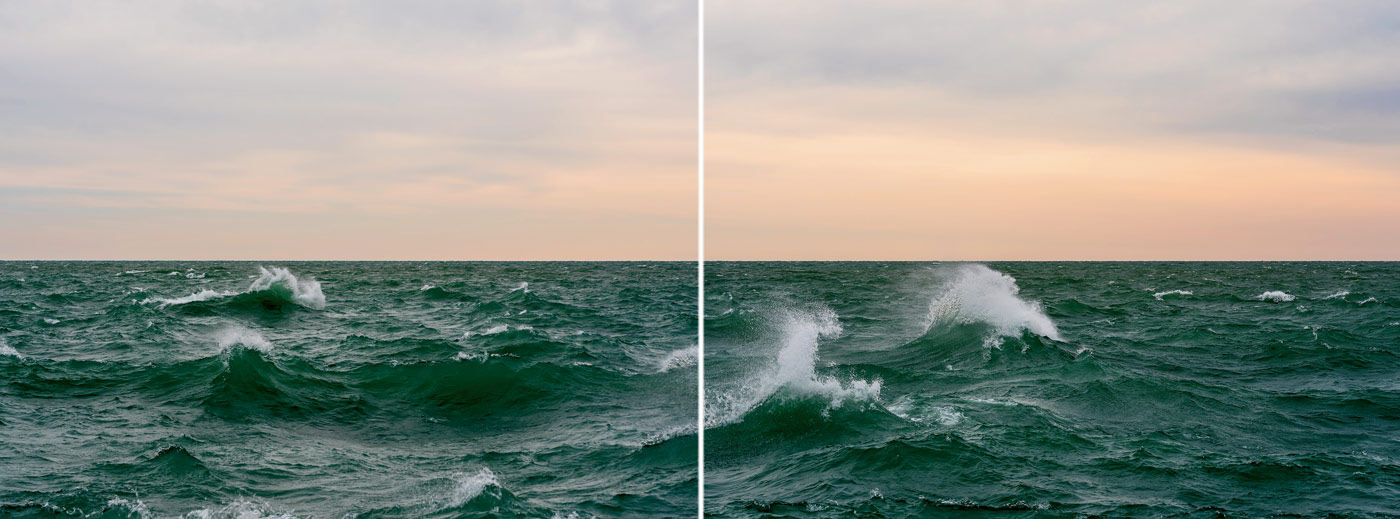ARTISTIC EVOLUTIONS
By Laura Layfer Treitman
PORTRAIT PHOTOGRAPHY BY JAMES GUSTIN
ART PHOTOGRAPHY BY LINCOLN SCHATZ
Artist Lincoln Schatz in his Chicago studio
By Laura Layfer Treitman
PORTRAIT PHOTOGRAPHY BY JAMES GUSTIN
ART PHOTOGRAPHY BY LINCOLN SCHATZ
Artist Lincoln Schatz in his Chicago studio

Nearly every day for the last seven years contemporary artist Lincoln Schatz has taken a photograph of Lake Michigan. The time and locations of the photos, captured while riding his bicycle to his studio, vary from dusk to dawn. “I think it’s about looking at something over and over again, perhaps obsessively. It is a trait that all my projects have in common,” says Schatz. What seems to set Schatz apart in his career, however, is less about the constant and more about the detours. His work has ranged from the movement of the water’s waves in his current Lake Series to documenting and digitizing political leaders through interviews and images in The Network, both the title of a book he authored and an exhibition now included in the permanent collection of the Smithsonian’s National Portrait Gallery (NPG).

“I’m a born and bred Chicagoan,” proclaims Schatz. “There was once a sense of feeling perhaps I had missed out on being an artist trying to make it in New York or Los Angeles, but the Midwest is truly home.” Growing up, his father was a part-owner of the popular Streeterville nightclub Chez Paree. It was a glamorous hotspot for dinner, drinks, and most of all, big-name headliners such as Lena Horne, Jimmy Durante, and Sammy Davis Jr. “Our house was a revolving door of these larger-than-life personalities whom my dad loved to invite over,” recalls Schatz. His mother was creative in her own right, working in painting, drawing, and calligraphy. On Saturdays, Schatz and his siblings went to art class in Old Town. “A friend of the family who was also an artist taught us about all different types of media and aesthetics. I have several of his pieces in my personal collection today that are reminders of that initial influence on me.” Schatz went on to attend Bennington College in Vermont, where he honed skills in sculpture, primarily metal, and photography. After graduation, he earned a fellowship with the Museum of Fine Arts, Houston.
“I remember the artist Martin Puryear, saying to me ‘you need to find a way to live making art.’” Schatz took the advice and began to channel his passions into a profession. In exchange for an old coal room as studio space, he made a deal with his dad to take on janitorial duties at the Chez Paree building. Schatz immersed himself in the local sculpture community, receiving large-scale commissions, but as he began to experiment with software to build prototypes to scale, he felt pulled back to the camera. “In the virtual realm, I felt the static object didn’t captivate me the same way. But when I added real-world physics, set my conditions and parameters, and focused on capturing images from the environment, the inevitable moment of lack of control from such subjects created the space where my art emerged.”

Schatz explored video and experimented with computational digital work in the early 2000s, just as the medium was becoming more prevalent in the market. When he heard about Manhattan’s bitforms Gallery and their representation of artists engaged in new technologies, he made a cold call and shortly after hopped on a plane for an in-person meeting that resulted in a decade of collaboration. “I traveled to art fairs around the world with them, showing my work, meeting collectors, curators, other dealers, and had a lot of fun being involved in that scene.”
Opportunities and acquisitions with corporations and museums developed for Schatz throughout this time period. In 2008, the Hearst Corporation, in honor of Esquire magazine’s 75th anniversary, commissioned Schatz to create portraits of the 75 most influential people of the 21st century. Schatz designed what he dubbed Cube Portraits, a 10’ x 10’ translucent box containing 24 cameras and computers that created “generative portraits”—an ever-changing series of video and still images expressing personality and movement. The subjects ranged from George Clooney and LeBron James to Samantha Powers and Jeff Bezos. “When we needed someone to dance with Clooney, my mother filled in!” Schatz fondly recalls.
Esquire’s Portrait of the 21st Century was acquired by the NPG for its permanent collection in 2010. During that period, while in Washington, D.C. for an appointment with Smithsonian curatorial staff, Schatz was struck with another idea. “I arrived early, wandered through some of the museums on the National Mall, and was incredibly moved by a show of Richard Avedon’s seminal work The Family on view at The Corcoran Gallery. I thought, wouldn’t it be interesting to document historical figures with generative portraiture?” When Schatz met with the Smithsonian staff later that same day, he shared his thoughts to invite political, journalistic, and social thought leaders as participants in this kind of endeavor. This was the genesis of The Network, video portraits of the dynamic people who help shape Americans’ everyday lives. Schatz interviewed powerful players such as Nancy Pelosi, Karl Rove, Cokie Roberts, Vernon Jordan, and even art collector Mera Rubell.
The scope of Schatz’s projects extended far beyond the Beltway. A series developed for the United States State Department’s Art in Embassies program in partnership with the Department of Defense honors members of the foreign service and active military. This video piece is currently in the collection of the U.S. Embassy in Kabul. Another video project Cure Violence: Portrait of an Epidemic, created in partnership with the University of Illinois, catalogs messages of more than fifty Chicagoans committed to ending gun violence.

Schatz seems to have always had a finger on the pulse of popular culture, identifying ground-breaking ways to use his art to better display and understand the complexity of American society. His work in the early 2000s was a harbinger for the future montage of personal face-to-face social media interactions currently created on Instagram and TikTok. More recently, Schatz has found himself turning to the outdoors. While water is easily accessible from his neighborhood landscape, redwood forests, aspen-covered mountains, the Great Plains, and even a Vermont dairy farm, also find prominence through Schatz’s lens. “My daughter will talk about the notion of ‘imposter syndrome,’ and I kind of think about that as I’m out there with my tripod. The camera has one set of demands that I prepare for, and then suddenly the trees, the sky, or the lake can reveal a completely different perspective right before my eyes. It can be a very humbling experience.”
He still occupies the same studio of his early days, reads voraciously, listens to lots of podcasts, and tests the science and engineering of new methods and mediums. “I have one assistant in the studio and right now we are exploring ways to alter large-scale photographs of trees into three-dimensional wall reliefs,” shares Schatz. “It’s really about changing our perspective. By creating the artwork as three-dimensional pieces we experience these artist-made fictional tree canopies in entirely new ways. When the work is at this larger scale, it becomes architectural. The impact is completely different from a framed artwork on paper.”

Schatz credits much of his success to family. His wife, Clare Pinkert, a lawyer, and their three children regularly practice patience when family trips are occasionally interrupted by frequent pauses for the perfect shot. Schatz’s late father, a veteran, would have been immensely proud of his son’s government-related collaborations and was himself adept at shifting between the worlds of diplomacy and fame. Obviously, the apple doesn’t fall far from the tree. Schatz’s abilities as an artist to move from the studio into plein air and to comfortably interact with celebrities, national leaders, tech titans, and publishers are a rare combination and at the core of what good art intends to do: entertain, educate, and evolve.
Lincoln Schatz Studio is located at 299 East Ontario Street in Chicago, 312-787-8242, lincolnschatz.com.

Sign Up for the JWC Media Email